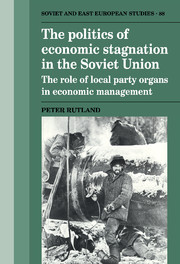 The Politics of Economic Stagnation in the Soviet Union
The Politics of Economic Stagnation in the Soviet Union Book contents
- Frontmatter
- Contents
- List of tables
- Preface
- Glossary of Russian terms and abbreviation
- Introduction: The party in the post-totalitarian system
- 1 The party and the economy: structures and principles
- 2 Party interventions in industry
- 3 Interventions in industry: case studies
- 4 The party as regional coordinator
- 5 Regional coordination: case studies
- 6 The party as fireman: party interventions in the transport and energy sectors
- 7 The role of the party in agriculture
- 8 Non-party control organs
- 9 The principles underlying the party's work with cadres
- 10 The obkom elite in the 1980s
- 11 Party and economy under perestroika
- Conclusion Party and economy in the USSR: from stagnation to collapse
- Appendices
- Notes
- Bibliography
- Index
- THE POLITICS OF ECONOMIC STAGNATION IN THE SOVIET UNION
11 - Party and economy under perestroika
Published online by Cambridge University Press: 06 July 2010
- Frontmatter
- Contents
- List of tables
- Preface
- Glossary of Russian terms and abbreviation
- Introduction: The party in the post-totalitarian system
- 1 The party and the economy: structures and principles
- 2 Party interventions in industry
- 3 Interventions in industry: case studies
- 4 The party as regional coordinator
- 5 Regional coordination: case studies
- 6 The party as fireman: party interventions in the transport and energy sectors
- 7 The role of the party in agriculture
- 8 Non-party control organs
- 9 The principles underlying the party's work with cadres
- 10 The obkom elite in the 1980s
- 11 Party and economy under perestroika
- Conclusion Party and economy in the USSR: from stagnation to collapse
- Appendices
- Notes
- Bibliography
- Index
- THE POLITICS OF ECONOMIC STAGNATION IN THE SOVIET UNION
Summary
After 1985, the established political and economic order began to fall apart. It is somewhat idle to speculate over whether the collapse was inevitable, or whether it could have been prevented or at least post-poned if Gorbachev had acted differently. Instead, this chapter will analyse developments from the point of view of the party's role in the economy.
In general, the years 1985 to 1991 showed the CPSU to be a very brittle organization. It displayed little ability to bend with the winds of change, and instead tried to persist in its old ways, until the whole structure shattered. Interestingly, while the party jettisoned its political powers one by one (control over the press, control over local Soviets, etc.), the regional party apparatus clung to its core role of economic supervision till the bitter end. Only with the suspension of the CPSU in August 1991 was the party's grip over the economy prised loose.
As glasnost and democratization took hold the traditional, routine duties of regional party organs were steadily overtaken by the accelerating pace of political change. Regional party officials found themselves fighting for their political survival in semi-free elections, and struggling to cope with a flood of additional challenges: ecological catastrophes, inter-ethnic strife, and a surge of worker unrest of unprecedented proportions.
- Type
- Chapter
- Information
- The Politics of Economic Stagnation in the Soviet UnionThe Role of Local Party Organs in Economic Management, pp. 206 - 217Publisher: Cambridge University PressPrint publication year: 1992
- 1
- Cited by
